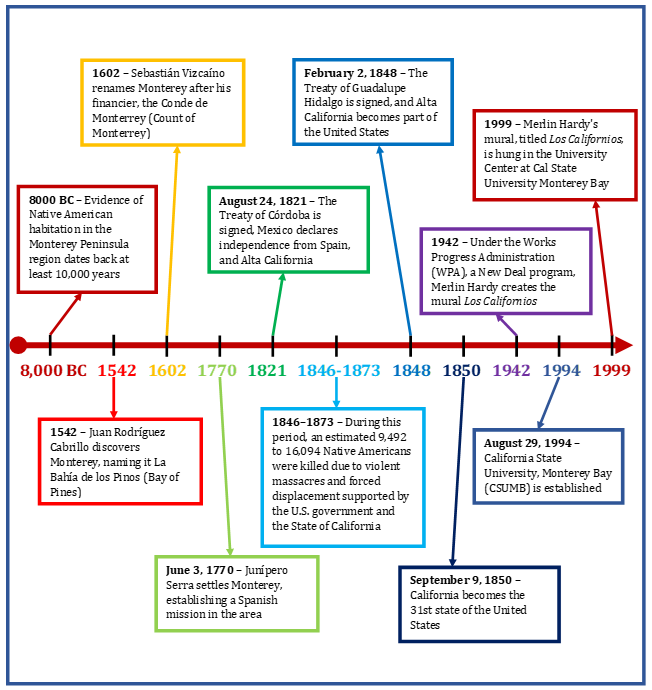Unveiling Controversy
Here at Cal State Monterey Bay, we showcase a diverse collection of art, ranging from pieces created as early as the 1900s to contemporary works in various media, including photography. These pieces, though thought-provoking, have stirred controversy due to their bold subject matter and the questions they raise about society, identity, and culture. In this space, we invite you to reflect on the significance of these works, engage with the differing viewpoints they provoke, and consider the role art plays in challenging the status quo.
Artist and Mural Description
The historic mural Los Californios by Merlin Hardy has been on permanent loan from the U.S. Army and displayed in the University Center (formerly Pomeroy Hall) since 1999. Originally located in
the ladies’ lounge of the Soldier’s Club at Fort Ord (Stilwell Hall), Los Californios was created during the Great Depression as part of the Works Progress Administration (WPA) initiative.The mural depicts a colonial Spanish fiesta scene from the early 1800s, featuring wealthy men and
women in traditional attire against the backdrop of a two-story Spanish structure reminiscent of the adobes in Old Monterey. It likely aimed to provide a visually appealing display for women visiting the lounge, showcasing the costume designs of the era.Why is this important?
Art, while a form of expression, also has the power to shape perceptions and reflect cultural values. This mural is a reminder that art must evolve with the times, and what was once acceptable may no longer resonate in a diverse and inclusive society.
What can we learn from this?
- Art is powerful – It can inspire, but also offend or marginalize.
- Reflection is key – We must ask ourselves: Who is represented? Who is excluded? Whose voices are heard, and whose are silenced?
- Growth is possible – Recognizing the hurt caused by this mural provides an opportunity for dialogue, understanding, and positive change.
This mural, while once celebrated, contains elements that have sparked concern and dialogue within our community. We recognize that it may evoke strong emotions, especially for those who feel marginalized or hurt by its imagery and messages.
We encourage you to take a moment to reflect on the impact this mural has on our community and join us in working toward a more inclusive future. Let's engage in conversation, learn from one another, and celebrate art that unites, not divides.
To better understand how this mural can be offensive to some, it is important to recognize the history of our region, the land we reside on, its original caretakers, and the colonial legacy that has shaped it. The archeological record reveals that Native Americans have inhabited this land for over 10,000 years. However, the arrival of Europeans began with the discovery of Monterey in 1542 and its subsequent colonization in 1770. In the span of just over 200 years, 10,000 years of peace and cultural heritage were disrupted, leading to the displacement, oppression, and erasure of Indigenous peoples.
This mural, with its colonial themes and depictions of affluence, can evoke painful memories of this destructive period. It may be seen as a reminder of the imperialist mindset that justified the exploitation and subjugation of native cultures. Additionally, the mural’s portrayal of wealth and power may feel disconnected from the lived experiences of those who have faced centuries of marginalization. Its aesthetic choices may also come across as outdated or out of touch, further alienating those who have long been impacted by colonialism. Together, these elements make the mural offensive, as it perpetuates harmful ideologies that ignore the profound injustices of our region’s history.

Thank you for being part of this important dialogue
The purpose of this is to inform and encourage thoughtful consideration—not to simply condemn the mural, but to acknowledge its problematic aspects. This approach could spark a meaningful conversation about how we can move forward together.
We are currently seeking funding to relocate the Los Californios mural. For those interested in supporting this effort, please contact University Advancement by telephone at (831) 582-3908 or via email at give@csumb.edu.
For additional information on the any of these murals, please contact the Cultural Heritage Collections Manager, Jordan Leininger at (831) 582-3479 or via email at jleininger@csumb.edu.